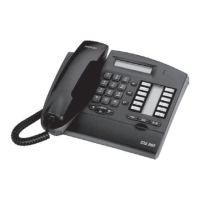25
ANSWERING CAMPED-ON CALLSCALL SERVER : TELEPHONE FEATURES
Ed. 04 1/2Réf. 3EH 21000 BSAA
File
ANSWERING CAMPED-ON CALLS
DESCRIPTION
When one or more callers (if the station has the necessary resources) are camped on a subscriber (see
"Camp-on on busy station or group"), the subscriber can either:
- consult the identity of the camped callers, if the station has soft keys
- answer (consult) one or more camped-on calls, without releasing the current communication, or
- answer a camped-on call by releasing its current communication. In this case, the system determi-
nes which camped-on call is presented to the station according to the priority of the calls camped-
on.
The level of priority depends on three criteria:
- the type of caller: internal, external or OS (for example, if a station has a caller camped on but has
no resources left, an OS call "breaks" the first camp-on and is itself camped on)
- the type of called party: Operator Group, Hunting Group or station
- the type of call: simple call, recall (for example after transfer failure, see "Conference") or hold re-
minder
The system allocates the following descending order of priority:
- external hold recall, delayed or otherwise
- internal hold recall, delayed or otherwise
- external callback
-external call
- internal callback
- call from an operator station
- internal call
- Operator Group call
- Hunting Group call
CONFIGURATION
T To specify whether or not to protect a station against camp-on:
T To specify whether or not to protect a station against the camp-on tone:
- by MMC-PM5 (Expert View): Subscribers/Basestations List -> Subscribers/Basestations List
-> Details -> Features -> "Camp-On Protection"
- by MMC-PM5 (Expert View):Subscribers/Basestations List -> Subscribers/Basestations List -
> Details -> Features -> "Warntone Protection"

